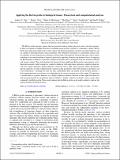Applying the Kelvin probe to biological tissues: Theoretical and computational analyses
Author(s)
Grodzinsky, Alan J.; Ahn, Andrew C.; Baikie, Iain D.; Gow, Brian J.; Martinsen, Ørjan G.; Zhao, Min; ... Show more Show less
DownloadAhn-2012-Applying the Kelvin probe to biological tissues.pdf (684.7Kb)
PUBLISHER_POLICY
Publisher Policy
Article is made available in accordance with the publisher's policy and may be subject to US copyright law. Please refer to the publisher's site for terms of use.
Terms of use
Metadata
Show full item recordAbstract
The Kelvin probe measures surface electrical potential without making physical contact with the specimen. It relies on capacitive coupling between an oscillating metal tip that is normal to a specimen's surface. Kelvin probes have been increasingly used to study surface and electrical properties of metals and semiconductors and are capable of detecting material surface potentials with submillivolt resolution at a micrometer spatial scale. Its capability for measuring electrical potential without being confounded by electrode-specimen contact makes extending its use towards biological materials particularly appealing. However, the theoretical basis for applying the Kelvin probe to dielectric or partially conductive materials such as biological tissue has not been evaluated and remains unclear. This study develops the theoretical basis underlying Kelvin probe measurements in five theoretical materials: highly conductive, conductive dielectric with rapid charge relaxation, conductive dielectric with slow charge relaxation, perfect dielectric, and tissue with a bulk serial resistance. These theoretically derived equations are then computationally analyzed using parameters from both theoretical specimens and actual biomaterials—including wet skin, dry skin, cerebrospinal fluid, and tendon. Based on these analyses, a Kelvin probe performs in two distinct ways depending on the charge relaxation rates of the sample: The specimen is treated either as a perfect dielectric or as highly conductive material. Because of their rapid relaxation rate and increased permittivity biomaterials behave similarly to highly conductive materials, such as metal, when evaluated by the Kelvin probe. These results indicate that the Kelvin probe can be readily applied to studying the surface potential of biological tissue.
Date issued
2012-06Department
Massachusetts Institute of Technology. Center for Biomedical EngineeringJournal
Physical Review E
Publisher
American Physical Society
Citation
Ahn, Andrew et al. “Applying the Kelvin Probe to Biological Tissues: Theoretical and Computational Analyses.” Physical Review E 85.6 (2012): 061901. © 2012 American Physical Society.
Version: Final published version
ISSN
1539-3755
1550-2376